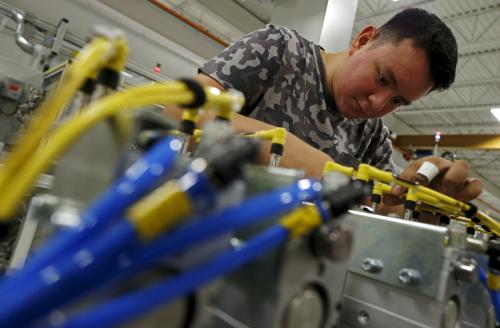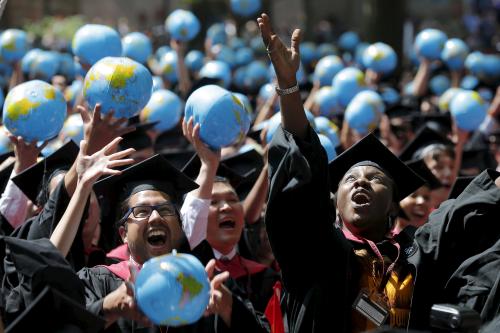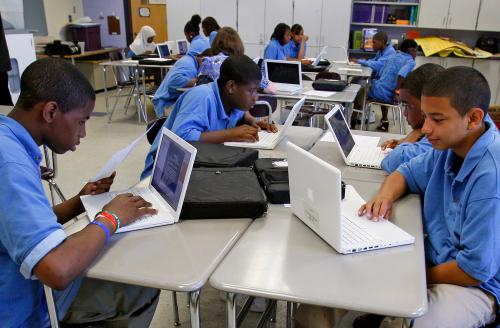This election taught me two things. The first is obvious: We live in a deeply divided nation. The second, while subtle, is incredibly important: The election was a massive cry for help. People across the country–on both sides of the political spectrum–feel they have been left behind and are fearful their basic needs will continue to go unanswered. Rhetoric may win votes, but it doesn’t put food on the table. There’s been much discussion of how we’re divided by race and class, but I believe a huge driver of our nation’s current challenges is created by educational inequity.
The persistent lack of access to world-class educational resources and technology in far too many communities is at the heart of this issue. This inequality breeds more than just subpar test scores. It snowballs to create economic immobility, stranding people without the training necessary to earn well-paying jobs. As the job landscape evolves–STEM jobs are growing 70 percent faster than non-STEM jobs–we need to create opportunities for people to develop 21st-century skills and level the playing field for all demographics.
The strong reactions to new U.S. Secretary of Education Betsy DeVos’s confirmation hearing last month illustrates the importance of education to all factions of our nation. We need to be prepared to find a solution that provides opportunity for all Americans and bolsters our economy. I urge policymakers to make technology education a national priority.
By 2020, demand for skilled technologists will exceed the number of qualified applicants by 1 million, leaving our country vulnerable in key areas such as technological innovation, economic development, and cybersecurity. Our inability to resolve the digital skills shortage is bleeding the U.S. economy of approximately $1 trillion annually.
When compared to 17 other industrial countries, U.S. workers ranked last in “problem solving in technology-rich environments.” If we expect to compete in a global economy that demands increasingly higher skills, we need to concentrate on closing the digital divide. The reversal must begin in K-12, where currently only one in four schools teach computer programming.
The impact of this skills gap is easy to see across local economies. Georgetown University predicts there will be an estimated 228,000 STEM-related jobs in Michigan by 2018, but as Detroit public schools rank the lowest among big-city districts in math—with only 4 percent of eighth graders scoring proficient or better—the question lingers: Who will fill those roles?
Rhode Island is home to a number of large companies, including Hasbro, Amica Mutual Insurance, CVS Pharmacy, and FM Global. While these companies actively seek skilled workers to fill technical roles, state unemployment remains above the national average. This disparity can be hard to understand, until you realize the unemployed population is not equipped with the hard skills needed to succeed in these types of positions. Until things change in education, this gap will continue to grow. In 2015, when unemployment was at 6.1 percent, just 42 students in the entire state took the AP Computer Science exam. Through Computer Science for Rhode Island, Democratic Gov. Gina Raimondo has set forward an ambitious plan to put computer science in every school, but we need support at the federal level to accelerate such state efforts.
We’re doing students a disservice by not placing a heavier focus on producing STEM graduates, who are more sought after than any other major, and stand to earn higher initial salaries than their peers. Nationwide, there are more than 512,000 open computing jobs, but the number of computer science students that graduated into the workforce last year account for less than 10 percent of that need. Of course, we wouldn’t expect new graduates to fill all job vacancies in a healthy labor market—as many open positions will require more experience—but filling less than 10 percent is indicative of demand for talent far outstripping supply. It’s clear our educational institutions are not producing enough workers to keep up with the demand that rapid innovation has imposed on our economy.
As such, we must also provide training resources that move at the ever-increasing speed of technology to those in higher education and the workplace. The TechHire initiative, a federal campaign focused on building tech talent pipelines in communities across the United States, is an important step in this direction. While it isn’t the singular solution, the program serves as a model for the kind of public-private partnerships that are suited to address the massive shortfall in technical talent. I encourage the incoming administration to facilitate efforts of employers who need skilled workers, people who need the training to get and keep a well-paying job, and training providers that offer tools to drive technology skills development and mastery. This is a place where everyone’s interest align—from government to the private sector to schools nationwide—and the Education Department is primed to play a leadership role in creating good jobs here in the U.S.
In my current role with Emerson Collective, we’re working to create jobs on the south and west sides of Chicago as a means to reduce the epidemic of violence that has engulfed the city. For example, through Emerson’s support of Chicago CRED, we are working to create opportunity for young men in Chicago to gain the skills and experiences they need to enter the work force and be successful. Our goal is to create concrete opportunities that get people off the streets and into jobs in the legal economy. People who have both hope and concrete opportunities don’t pick up guns.
To be successful in this endeavor, we need strong partners in the private sector. I joined the board at Pluralsight, a company that aims to democratize technology learning by addressing the skills gap for both individuals and corporations, for this exact reason. Our efforts at Emerson could be multiplied many times over by thoughtful and articulate policy from the White House that connects public and private efforts to provide underserved groups with tech skills training that will lead to long-term job placement.
The new administration is inheriting the challenge of educational inequality and is tasked with adopting a deliberate and comprehensive position on technology education that effectively unites the government, education, and technology sectors. This issue impacts everyone in the country, and too much is at stake for it to remain in the shadows of partisan issues. Education can be the thing that heals the painful divide in this nation, so long as we work together to map its future.
As people have been pushed to the margins of society, it has become more difficult to climb the economic ladder. Providing opportunity in the form of skills development will encourage economic mobility, strengthen families, keep good jobs in America, bolster our democracy, and replace the deep fear felt across the nation with hope. It’s our collective responsibility to help close the technology skills gap and empower our students and professionals to become the creators and problem-solvers we need to fuel the U.S. economy in today’s technology-driven world.







Commentary
Educational equality and excellence will drive a stronger economy
March 2, 2017